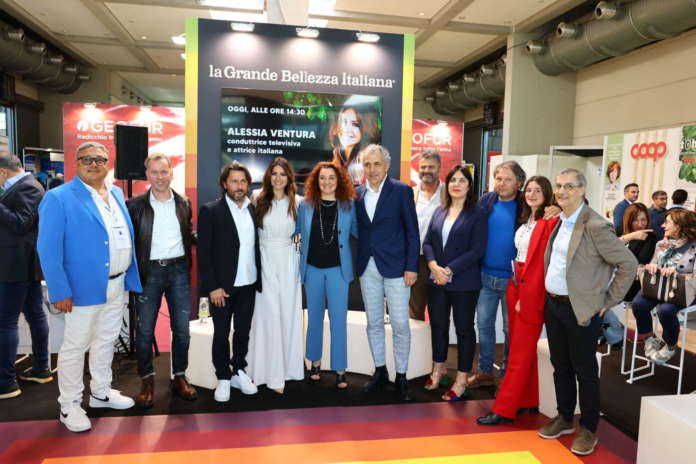È stata la prima rete di imprese avviata nel settore italiano dell’ortofrutta. E, a distanza di cinque anni, è rimasta anche l’unica. “Non è stato creato niente di analogo, benché siano state molte le aziende che ci hanno contattato per entrare nel nostro gruppo (ma le nostre porte sono chiuse)” ammette Leonardo Odorizzi, che è stato il “motore di avviamento” della rete di imprese ortofrutticole La Grande Bellezza Italiana.
Un progetto preparato per un paio di anni, con il supporto di Confindustria Verona, ma diventato realtà in poche settimane. Giusto il tempo di telefonare a cinque partner “giusti” (Bergonzoni, Coofrutta, Op Joinfruit, Op Geofur e Perusi). Ossia legati da rapporti di amicizia e di fiducia reciproca e accomunati da un impegno diretto nella produzione in Italia, da una visione condivisa e da un’offerta commerciale complementare e sinergica. E aperti ad aggregarsi per un obiettivo comune: costruire la massa critica necessaria per valorizzare le produzioni ortofrutticole nazionali.
Un obiettivo ben espresso nel brand prescelto che oggi ha una caratura internazionale, visto che raggiunge XXX paesi. Un naming azzeccato, aiutato anche da un colpo di fortuna: l’aver trovato disponibile il dominio La Grande Bellezza Italiana, nonostante l’eco del successo internazionale riscosso dal quasi omonimo film di Paolo Sorrentino.
Dunque, l’operazione La Grande Bellezza Italiana è partita con il vento a favore. Ma poi la navigazione com’è andata?
Siamo molto soddisfatti del nostro percorso, decisamente insolito nel settore ortofrutticolo, dove resistono oltre 7mila produttori privati e circa 300 Op. In questi cinque anni di attività abbiamo mostrato che si può fare aggregazione, abbiamo contribuito a portare valore alla filiera e abbiamo svolto un grande lavoro di comunicazione per difendere l’italianità e migliorare l’immagine dell’ortofrutta nazionale. Oggi siamo riconosciuti e riconoscibili, sia in Italia che all’estero.
Quali sono state le maggiori difficoltà?
La principale è stata quella di far capire la nostra realtà di rete d’imprese, visto che si tratta di un modello innovativo per il mondo ortofrutticolo. Uno sforzo inserito in uno scenario non facile, caratterizzato dalla crescita della concorrenza di alcuni paesi produttori (come quelli dell’area mediterraneo) e dall’altro da un certo “svilimento” dei prodotti ortofrutticoli italiani, troppo spesso sono stati penalizzati a livello di prezzo. Poi è arrivato anche il Covid, che ha avuto un impatto pesante e ha bloccato molti progetti. Ma con la fine della pandemia siamo tornati a incontrare i clienti e siamo ripartiti. Il 2023 lo abbiamo chiuso con oltre 100 milioni di euro di fatturato e con il raddoppio del giro d’affari del brand La Grande Bellezza Italiana. Inoltre l’export è arrivato al 50% del fatturato.
Dunque, sui mercati esteri l’italianità è ancora vincente?
Sì, ma solo se si esce dalle logiche di standardizzazione che sono state imposte negli ultimi anni, abbiamo perso il valore sensoriale ed emozionale della frutta e della verdura italiana. Ed è su questi aspetti, invece, che dobbiamo puntare. Come? Proponendo prodotti di alta qualità, con posizionamento premium e con una denominazione, come l’Igp, che li posiziona come frutti di un territorio, con una storia alle spalle e un portato di valori emotivi importante. Ma anche dotati di un marchio che sia sinonimo di eccellenza italiana. E su questi fronti il nostro brand non ha rivali. Oggi contribuisce per il 10% al nostro fatturato ma io spero che riusciremo a portarlo presto al 30%.
Come ci riuscirete?
Continuando a mantenere relazioni dirette con i retailer internazionali, a garantire continuità nelle forniture (come facciamo soprattutto nelle pesche e nettarine) e a proporre prodotti che portano fatturato aggiuntivo ai retailer, com’è successo al sud con i nostri radicchi. E poi vogliamo continuare a proporre i nostri prodotti in modo “spettacolare” e distintivo, come dimostrano le piramidi realizzate nei punti vendita con le confezioni impilabili delle nostre clementine.
Quali sono, più in generale, le direttrici di crescita de La Grande Bellezza Italiana?
Non quella societaria, perché per la nostra società di capitali non prevediamo l’ingresso di altri soci. L’obiettivo, invece, è quello di far crescere le vendite delle nostre produzioni, rafforzando i rapporti già avviati con le catene della Gdo ed entrando in retailer minori ma importanti a livello locale e interessati a nicchie di prodotto. In effetti la valorizzazione commerciale delle produzioni ortofrutticole tutelate da un’indicazione geografica europea è uno dei vostri fiori all’occhiello.
Sì, e ne siamo molto orgogliosi di aver dato voce a prodotti che, da soli, incontravano difficoltà a livello commerciale per mancanza di conoscenze e risorse. Il successo riscosso in Gdo dalle Clementine del Golfo di Taranto Igp e l’introduzione della Pera Mantovana Igp in Esselunga sono due risultati importanti, che testimoniano quali potenzialità abbiano le piccole produzioni d’eccellenza se adeguatamente valorizzate. Ma anche l’espansione delle vendite dei radicchi al sud è un ottimo esempio.
Oggi avete in assortimento una quindicina di prodotti ortofrutticoli e sette produzioni Igp. Cosa vi manca?
I “fondamentali” del made in Italy li abbiamo e, per valore di fatturato, sono mele, pesche e nettarine, radicchi, clementine e uva ci sono. Certo ci piacerebbe rafforzarci nelle brassiche (penso ai cavolfiori colorati) e nel finocchio, ma anche trovare spazio in Gdo anche per i nostri mirtilli e lamponi di montagna.
Ci sono prodotti di nicchia che giudica interessanti?
Sì, soprattutto per quelli pugliesi, come il carciofo violetto, che considero un prodotto con un buon potenziale. Del resto i risultati che abbiamo raggiunto con la Pesca di Verona Igp mostrano che le sfide, anche se difficili, si possono vincere.
Perché ritiene così importante il progetto Pesca di Verona Igp?
Per due motivi: perché abbiamo ridato lustro a un prodotto d’eccellenza e perché siamo riusciti a coinvolgere quattro giovani produttori, tutti sotto i 30 anni. La mancanza di giovani in campagna è un tema drammatico e assolutamente sottovalutato e sotto rappresentato. Noi stessi sei soci non abbiamo eredi che vogliano portare avanti il nostro lavoro. Per questo il risultato ottenuto nella pesca di Verona ci fa ben sperare. Sempre pensando ai giovani, e per incentivare il consumo di ortofrutta, abbiamo deciso di puntare maggiormente sui social e abbiamo avviato un concorso con tre istituti scolastici superiori di Verona per trovare nuovi modi per comunicare con i giovani.
Quali saranno gli altri fronti prioritari del 2024?
Vogliamo coinvolgere di più i collaboratori e la base produttiva, ad esempio nelle fiere e nella comunicazione. Noi soci siamo molto presenti e molto allineati, ma per lavorare bene è necessario aumentare il senso di appartenenza di tutti gli operatori della filiera. •
—–
Bringing the Italian brand back to the world
Premium positioning to rediscover the sensorial and emotional value of fruit and vegetables with a network of companies, La Grande Bellezza Italiana is a unique in the sector
It was the first network of companies launched in the Italian fruit and vegetable sector. And, five years later, it is also the only one left. Leonardo Odorizzi, who leads La Grande Bellezza Italiana as its president, and who was its ‘starter motor’, admitted: ‘Nothing similar has been created, although many companies have contacted us to join our group (but our doors are closed)’. This project has been prepared for a couple of years, with the support of Confindustria Verona, but it became reality in just a few weeks. Just enough time to call five ‘right’ partners (Bergonzoni, Coofrutta, jJoinfruit PO, Geofur PO, and Perusi). That is to say, linked by relationships of friendship and mutual trust and united by a direct commitment to production in Italy, by a shared vision, and by a complementary and synergistic commercial offer. And open to associating for a common goal: building the critical mass necessary to enhance Italian fruit and vegetable production. This objective is well expressed in the chosen brand, which today has an international calibre, given that it reaches xxx Countries. An apt naming, also helped by a stroke of luck: having found the domain La Grande Bellezza Italiana available, despite the echo of the international success achieved by Paolo Sorrentino’s almost homonymous film.
Therefore, ‘La Grande Bellezza Italiana’ operation started with the wind in its favour. But how did the navigation go?
We are very satisfied with our path, decidedly unusual in the fruit and vegetable sector, where there are over 7 thousand private producers and around 300 POs. In these five years of activity we have shown that aggregation can be done, we have contributed to bringing value to the supply chain, and we have carried out a great communication work to defend Italian style and improve the image of national fruit and vegetables. Today we are recognized and recognizable, both in Italy and abroad.
What were the biggest difficulties?
The main one was to make our reality as a business network understood, given that it is an innovative model for the fruit and vegetable world. An effort placed in a difficult scenario, characterized by the growth of competition from some producing Countries (such as those in the Mediterranean area), and on the other hand by a certain ‘debasement’ of Italian fruit and vegetable products, which have too often been penalized in terms of price. Furthermore, Covid also arrived, which had a heavy impact and blocked many projects. But with the end of the pandemic we went back to meeting customers and started again. We closed 2023 with over 100 million Euros in turnover and with the doubling of the turnover of La Grande Bellezza Italiana brand. Furthermore, exports have reached 50% of the turnover.
So, is Italian style still a winner on foreign markets?
Yes, it is, but only if we move away from the standardization logic that has been imposed in recent years, we have lost the sensorial and emotional value of Italian fruit and vegetables. And it is on these aspects, however, that we must focus. How can we do? Proposing high quality products, with a premium positioning and a designation, such as PGI, which positions them as fruits of a territory, with a history behind them and an important emotional value. But also equipped with a brand that is synonymous with Italian excellence. And on these fronts our brand has no rivals. Today it contributes for 10% of our turnover, but I hope that we will soon be able to raise it to 30%.
How will you do it?
Continuing to maintain direct relationships with international retailers, to guarantee continuity in supplies (as we do especially for peaches and nectarines) and to propose products that bring additional turnover to retailers, as happened in the South with our radicchio. And then we want to continue to offer our products in a ‘spectacular’ and distinctive way, as demonstrated by the pyramids created in the stores with the stackable packages of our clementines.
What are, more generally, the growth guidelines of La Grande Bellezza Italiana?
Not the corporate one, because for our joint-stock company we do not foresee the entry of other partners. The objective, however, is to increase the sales of our products, strengthening the relationships already established with large-scale retail chains and entering smaller but important retailers at a local level and interested in product niches.
In fact, the commercial enhancement of fruit and vegetable production protected by a European geographical indication is one of your flagships.
Yes, it is, and we are very proud of having given voice to products that, on their own, encountered commercial difficulties due to lack of knowledge and resources. The success achieved in large-scale distribution by PGI Clementine of the Gulf of Taranto and the introduction of PGI Pear from Mantua in Esselunga are two important results, which demonstrate the potential of small excellent productions, if adequately enhanced. But the expansion of radicchio sales to Southern Italy is also an excellent example.
Today you have around fifteen fruit and vegetable products and seven PGI products in your assortment. What are you missing?
We have the ‘fundamentals’ of Made in Italy and, in terms of turnover value, there are apples, peaches and nectarines, radicchio, clementines, and grapes. Of course, we would like to strengthen ourselves in brassicas (I am thinking of coloured cauliflowers) and fennel, but we would also like to find space in large-scale retail trade for our blueberries and mountain raspberries.
Are there any niche products that you find interesting?
Yes, there are, especially for those from Puglia, such as purple artichoke, which I consider a product with good potential. Moreover, the results we have achieved with PGI Peach from Verona show that challenges, even if difficult, can be overcome.
Why do you consider PGI Peach from Verona project so important?
For two reasons: because we have restored prestige to an excellent product and because we managed to involve four young producers, all under 30. The lack of young people in the countryside is a worrying and absolutely underestimated and under-represented issue. We ourselves, six partners, have no heirs who want to continue our work. This is why the result obtained for Peach from Verona gives us hope. Always thinking of young people, and to encourage the consumption of fruit and vegetables, we decided to focus more on social media and started a competition with three high schools in Verona to find new ways to communicate with young people.
What will be the other priority fronts in 2024?
We want to involve our collaborators and the production base to a greater extent, for example at trade fairs and in communication. We members are very present and very aligned, but to work well, it is necessary to increase the sense of belonging of all operators in the supply chain.










